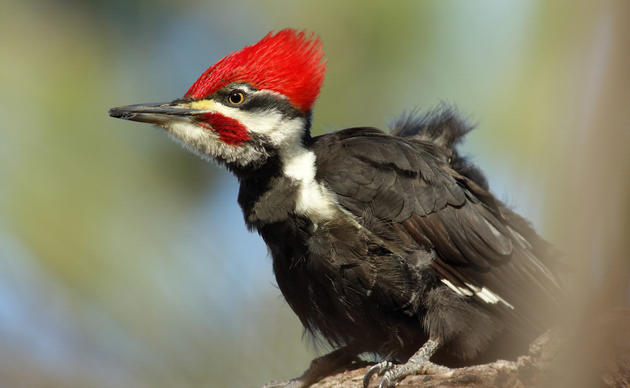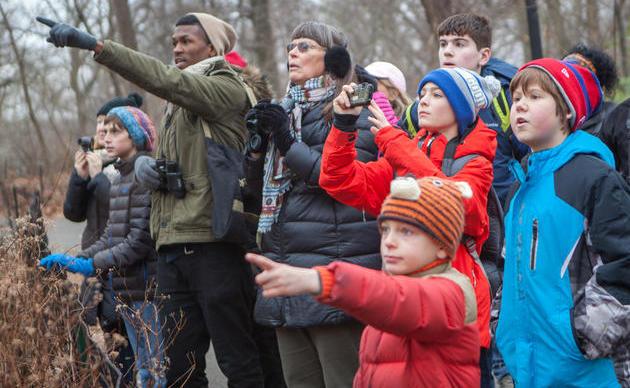How to Tell If a Songbird Needs Help
Before taking action to assist any wild animal, please also be sure to visit our "How to Help Distressed Birds and Other Wildlife" web page. The key to helping an animal in distress is to understand its normal behavior. Please review the information below to learn more about the behavior of songbirds.
Young songbirds are often “bird-napped” by well-intending people who have mistaken a very normal situation for something being wrong. Depending on the species and age of the bird, a young songbird on the ground may be a completely normal occurrence. No one can raise a baby bird as well as the bird’s parents, so we do NOT want baby birds to be taken away from their parents unless they are sick, injured, or truly orphaned.
Reading about the different ages of songbirds can help you determine if the baby is actually in need of help.
HATCHLINGS & NESTLINGS
Hatchlings and nestlings are very young birds that need to remain in the nest to survive. They should never be on the ground (unless they are a species of ground-nesting birds). If the species is a ground-nesting bird, the bird will usually be in a nest in a protected area such as near bushes.
Hatchlings are either featherless, have thin down, or have early stages of feather growth. Their eyes are closed for at least the first week or so after they hatch (varies with species). They are not able to make their own body heat and need to be kept warm by the mother bird.
Nestlings have the start of feathers over their bodies, often being fully feathered by 2 weeks of age (varies with species). They have the beginnings of flight feathers on their wings. They are more mobile in the nest but are not yet able to stand, hop, or walk. Sometimes older nestlings may fall out of the nest when they are wiggling around inside or beginning to perch.
IF YOU FIND A HATCHLING OR NESTLING ON THE GROUND IT IS AN EMERGENCY. It must be rescued and warmed right away. "How to Help Distressed Birds and Other Wildlife" web page for details on how to make a makeshift nest and provide supplemental heat for young songbirds. Also, be sure to contact a licensed Wildlife Rehabilitator ASAP for further direction.
FLEDGLINGS
Did you know that many songbird species learn how to fly from the ground? When growing songbird babies become too big for their nest, they will actually hop out (fledge the nest) and spend several days on the ground before their feathers are long enough to fly. This age is called the “fledgling” stage. Fledglings are fully feathered, but still have a very short tail and short wing feathers. The plumage of the fledgling bird is much duller, drab, and ragged looking than the adult plumage. They are able to sit upright, perch, and can hop or even flutter in short bursts. The baby appears to be alone on the ground, but the parent birds remain nearby in the trees and come down regularly to feed the baby, anywhere from several times an hour to every 1 or 2 hours. The baby will often hide itself in the grass or by low bushes for protection. This situation is completely normal for many songbirds.
Characteristics of healthy fledglings:
- Bright, clear eyes
- Able to stand, jump, hop, flutter
- Parent seen/alarm call heard in nearby tree
“Hopping and fluttering” is normal, as their flight feathers are not completely grown in. Fledglings can be easily mistaken for injured adults. One way to tell if a bird is a fledgling is if it has a short tail. Fledglings tail feathers are not done growing, and will be very short (up to 1 – 1.5 inches long, depending on the species), rather than the full grown long tail of the adult.
IF YOU FIND A FLEDGLING ON THE GROUND, observe the fledgling for up to two hours to see if a parent bird comes down to feed it. BE SURE TO OBSERVE FROM A DISTANCE and at a location hidden from view of the baby/parent bird, such as inside a house looking out a window. If you are within sight of the parent, it WILL NOT come down to the baby.
Many species of songbirds do NOT fledge on the ground. Please always take a photo of the fledgling and contact a licensed Wildlife Rehabilitator, who can help you evaluate the situation.
ADULTS
Adult songbirds can become injured and sick for a multitude of reasons. The most common reasons include getting attacked by house cats, being hit by cars, window strikes, bacterial and viral illnesses contracted at bird feeders, and many more.
Characteristics of adult songbird in need:
- On the ground not moving
- Does not fly away when approached
- Easily picked up
- Extremely fluffed up feathers
- Eyes closed, squinted, crusty, weepy, swollen, bleeding
- Evidence of blood or wounds
- Obvious injured limb (dangling leg, drooping/hanging wing, wings not symmetrical)
- Tries to fly but can’t
IF YOU FIND AN INJURED ADULT SONGBIRD, it must be rescued and transported to a licensed Wildlife Rehabilitator right away. See "How to Help Distressed Birds and Other Wildlife" web page for details on how to contain adult wildlife and for information on contacting a licensed Wildlife Rehabilitator ASAP for further direction.
How you can help, right now
Learn & Explore
Where birds thrive, people prosper. Help us transform local communities into places where birds flourish. Learn what you can do to nurture wildlife, nature, and conservation in Connecticut.
Support Our Work
Through land stewardship, science, education, and advocacy, we work to preserve habitat and protect bird species that are of state, national, and global concern. Your gift makes a difference.
Join Our Family
When you become a member of Sharon Audubon Center, you are protecting critical woodlands and a natural heritage for generations to come. Help us do great things.



